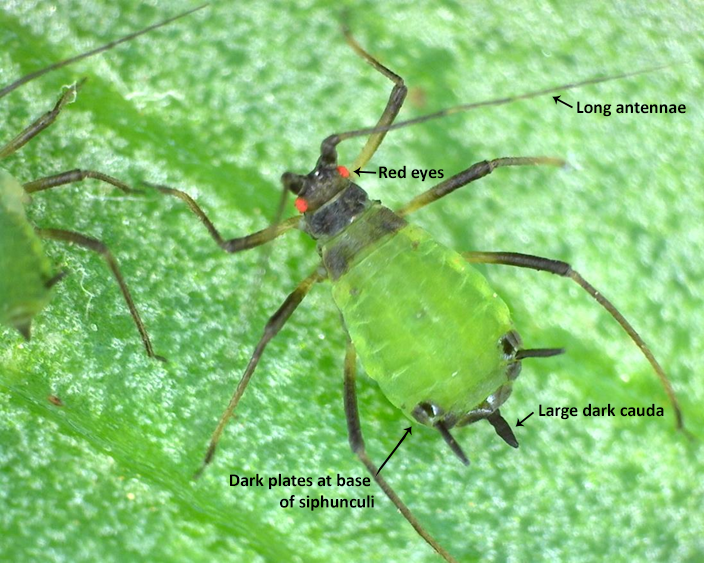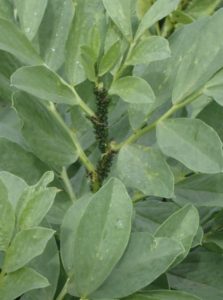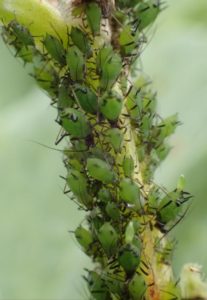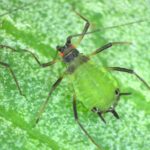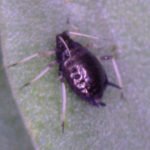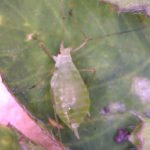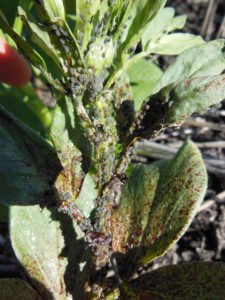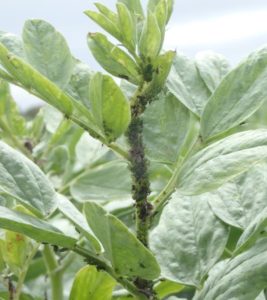Megoura crassicauda has been found in parts of north-east and central New South Wales (Sydney, Tamworth, and Breeza). The species originated in north-east Asia, and is closely related to the vetch aphid (Megoura viciae), found in Europe, Ethiopia and North America. Its host range is mostly limited to Vicia species – vetches, faba or broad beans, and may extend to Australian native vetches and vetch weeds.
At this point its distribution in Australia is unknown. Since the original detection in a Sydney backyard in October 2016, the only two additional detections have been in faba bean field trials at Breeza and DPI’s Tamworth research station. Field reports from agronomists and growers will help determine where they are present – so keep an eye out.
The damage potential of this species, both in terms of direct feeding damage from the infestations, and their potential as vectors of viruses is unclear. There is very little literature from overseas on this species as a pest of field crops.
Even though this pest has only recently been recorded in Australia, its host range, biology, and the distance between detection locations means eradication is not likely to be technically feasible.
Identifying M. crassicauda and distinguishing it from other pulse-infesting aphids
Adult M. crassicauda are large green aphids with red eyes and darkened areas on the head, thorax, legs, siphunculi and cauda. The species is larger than the other common aphid species with dark body parts found in faba bean, the cowpea aphid (Aphis craccivora).
Close-up of adult M. crassicauda adult, and colonies on faba bean.
Images of Megoura in this article have been provided by NSW DPI.
Two other species of aphid that commonly occur in pulses are the cowpea aphid and pea aphid. These can be easily distinguished from M. crassicauda using the following features:
| Species |
|
Cowpea aphid |
Pea aphid |
| Body colour |
Bright green |
Dark green to black; nymphs green-grey |
Green (can vary between brown–green–pinkish) |
| Eye colour |
red |
black |
red |
| Appendages |
Legs, cauda and siphunculi dark. Small, dark plates where siphunculi join the body. |
Legs white and black. Siphunculi black. |
Legs, cauda and siphunculi green-brown with black joints. Siphunculi and cauda long. |
| Antenna length |
Longer than body |
Short |
Longer than body |
Cowpea aphid (left) has been the predominant aphid species on faba beans in past seasons. A Megoura colony can be seen on the right. Both colonies pictured contains mainly nymphs.
Although the damage potential of this species is unclear; in the event of heavy infestation and little natural enemy activity, it may be prudent to treat. There are no insecticides currently registered for this pest, however an application for an Emergency permit for the use of pirimicarb, chlorpyrifos and lambda cyhalothrin is currently being assessed. New South Wales DPI has used pirimicarb to control this and other species of aphids in faba bean trials.
GRDC has requested that suspected sightings of this aphid be reported. In the first instance, contact the NSW DPI or Qld DAF entomologists for confirmation of identification. They will inform the relevant Biosecurity entity.
- Tamworth: NSW DPI. Zorica Duric 0422 253 866 ([email protected])
- Toowoomba: Qld DAF. Melina Miles 0407113 306 ([email protected])
Further reading:
Hales, D et al (2017). First detection of ‘Megoura crassicauda’ Maudvilko (Hemiptera: Aphididae) in Australia and a review of its biology. General and Applied Entomology 45:77-81.
F.C Tsaganou et al (2004). Effect of Aphis gossypii Glover, Brevicoryne brassicae (L.), and Megoura viciae Buckton (Hemiptera: Aphidoidea) on the development of the predator Harmonia axyridis (Pallas) (Coleoptera: Coccinellidae). Biological Control 31(2):138-144

